Lecture #2: Spinal Cord, Spinal Nerves, Suboccipital Region, Thoracic Wall
1/86
There's no tags or description
Looks like no tags are added yet.
Name | Mastery | Learn | Test | Matching | Spaced |
|---|
No study sessions yet.
87 Terms
How many pairs of spinal nerves are there?
31
How many pairs of cranial nerves are there?
12
The gray matter or the collection of nerve cell bodies in the CNS is called what?
Nucleus
The gray matter or the collection of nerve cell bodies in the PNS is called what?
Ganglion
The white matter or the collection of nerve cell bodies in the CNS is called what?
Tract
The white matter or the collection of nerve cell bodies in the PNS is called what?
Nerve
From what part of the body does the spinal cord descend from Caudally?
Brainstem/medulla Oblongata through the foramen magnum
What surrounds the spinal cord as it passes through the Vertebral Canal?
Dural (thecal) Sac
What purpose do the Lumbo-sacral enlargments serve along the spinal cord?
Gives rise to roots of spinal nerves for the brachial and lumbar plexuses (Upper and Lower extremities)
Where does the spinal cord end
L1-L2 in the conus medullaris
What nerve roots give rise to the Cauda Equina?
Lower lumbar, Sacral, and Coccygeal spinal nerves
Filum Terminae
a slender strand of fibrous tissue extending from the conus medullaris to the coccyx
How far does the dural sac extend?
S2
Dura
Projects laterally at each intervertebral level to encompass roots of spinal nerves
Arachnoid
Pressure of CSF keeps this layer attached to the Dura
Denticulate Ligaments
Found between emerging nerve roots, and penetrate arachnoid, and attach to the dura to stabilize the cord
Where arteries and veins lie to supply the spinal cord
Subarachnoid space
Choroid Plexus
Where CSF is produced in the brain
Venous Dural Sinuses
Where CSF is absorbed from subarachnoid space into the cranial network
CSF
clear, colorless liquid that fills the ventricles and canals of CNS; functions as a shock absorber; creates bouyancy for spinal cord
Lumbar Cistern
Where the subarachnoid space terminates caudally
Lumbar Puncture
Tightly flexed posture; needle inserted at L3/L4 or L4/L5; needle may encounter nerve roots but they will move out of the way
Spinal Anesthesia (Epidural)
tightly flexed posture, needle inserted into L3/L4 or L4/L5 however the needle does not go in as deep
Caudal Anesthesia
Needle enters through the sacral foramina and into the vertebral canal
Arteries that supply the spinal cord
anterior and posterior spinal arteries; Radicular and medullar spinal arteries that enter through the IV foramina
Anastomosis of vertical spinal vessels
communication between aorta and spinal vessels through the segemtnal medullar arteries in the sub-arachnoid space
Somatic Nerves
Part of the PNS; includes motor and sensory nerves
Somatic Motor Nerves (GSE)
Part of the PNS; carries outputs efferently from CNS to stimulate tonic, reflexive, and voluntary contraction of skeletale muscle
Somatic Sensory Nerves (GSA)
Part of the PNS; carries info afferently to the CNS through sensory ganglia for touch, pain, temperature from body wall; and pain/proprioception from muscles, tendons, and joints
Visceral Motor Nerves (GVE)
Part of the PNS, but make up the ANS; innervate smooth muscles, regulate glands, innervate cardiac muscle
Visceral Sensory Nerves (GVA)
Part of the PNS, but make up the ANS; visceral reflexes, convey visceral sensations (hunger, nausea); poorly localized pain; also responsible for referred pain
The amount of nerves between the CNS and either skeletal muscles innervated by GSE fibers OR sensory receptors innervated by GSA fibers
1 Nerve
Dermatome
A specific area of the body wall that GSA and GSE supply; area of skin supplied by the somatic afferents in one pair of spinal nerves; these also overlap each other
Myotome
A specific muscle mass in which the GSA and GSE fibers supply
What results from stimulus by Lower Motor Neurons in the brainstem or spinal cord?
Contraction of skeletal muscle
Which side do the lower motor neurons lie on when innervating their muscle?
Ipsilateral
Where are the cell bodies of lower motor neurons found?
Ventral horns of spinal gray
Dorsal Root
Comprised of somatic afferents carrying info from periphery to CNS
Ventral Root
Comprised of somatic efferents carrying info from CNS to periphery
Ganglion
collection of nerve cell bodies in the peripheral nervous system
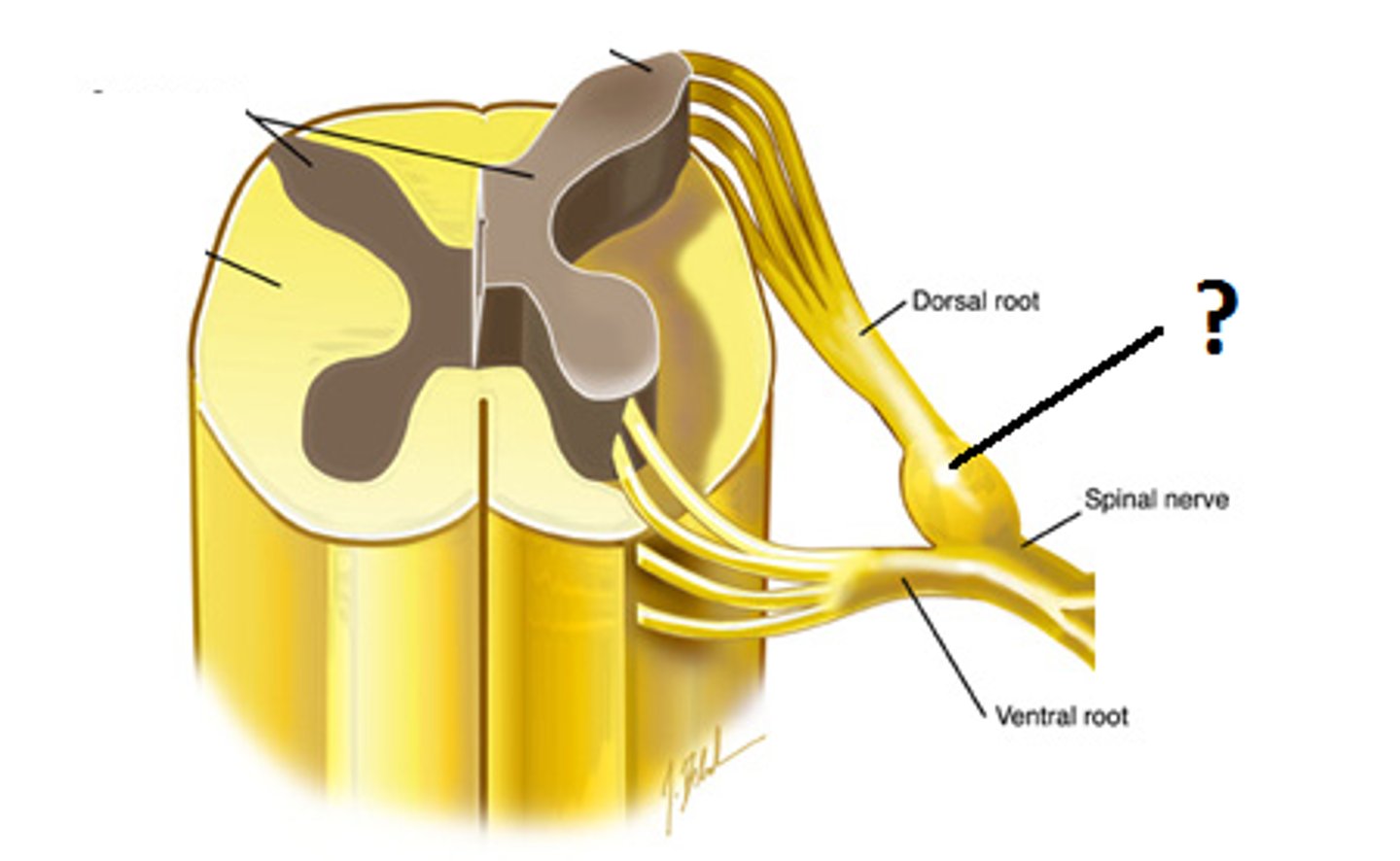
Dorsal Ramus
MIXED spinal nerve in an Intervertebral foramen that splits into a smaller segment towards the back of the body
Ventral Ramus
MIXED spinal nerve in an intervertebral foramen that splits into a bigger segment towards the front of the body
Which root are ganglions located
Dorsal Root
Ventral Ramus Innervations
Anterolateral body wall; Hypaxial muscles; Extremities
Dorsal Ramus Innervations
Skin of back and posterior scalp; epaxial muscles (erector spinae muscles); Facet joints; posterior spinal ligaments
Number of Cervical spinal nerves
8 pairs
Posterolateral herniated Lumbar disc
will usually compress the roots of the spinal nerve emerginf through the next intervertebral foramen DOWN
Posterior Herniation of Lumbar disc
May affect multiple nerve roots in the cauda equina
Irritative Peripheral Nerve Injuries
Caused by acute or chronic mechanical trauma or inflammation; if Sensory fibers stimulated: pain, or parasthesia (altered sensation); if Motor fibers stimulated: spasm, twitching of skeletal muscles
Destructive Peripheral Nerve Injuries
Trauma or neuropathy; Motor symptoms: paralysis or paresis of skeletal muscles; Sensory symptoms: Anesthesia or hypesthesia (diminished sensation), also pain or dysesthesia
Articular Columns
Cervical facet joints stacked ontop of each other
Nuchal Lines
site where muscles of the posterior neck and back attach to the skull

Occipital Condyles
Articulates with C1 (Atlas) which is why C1 has no body
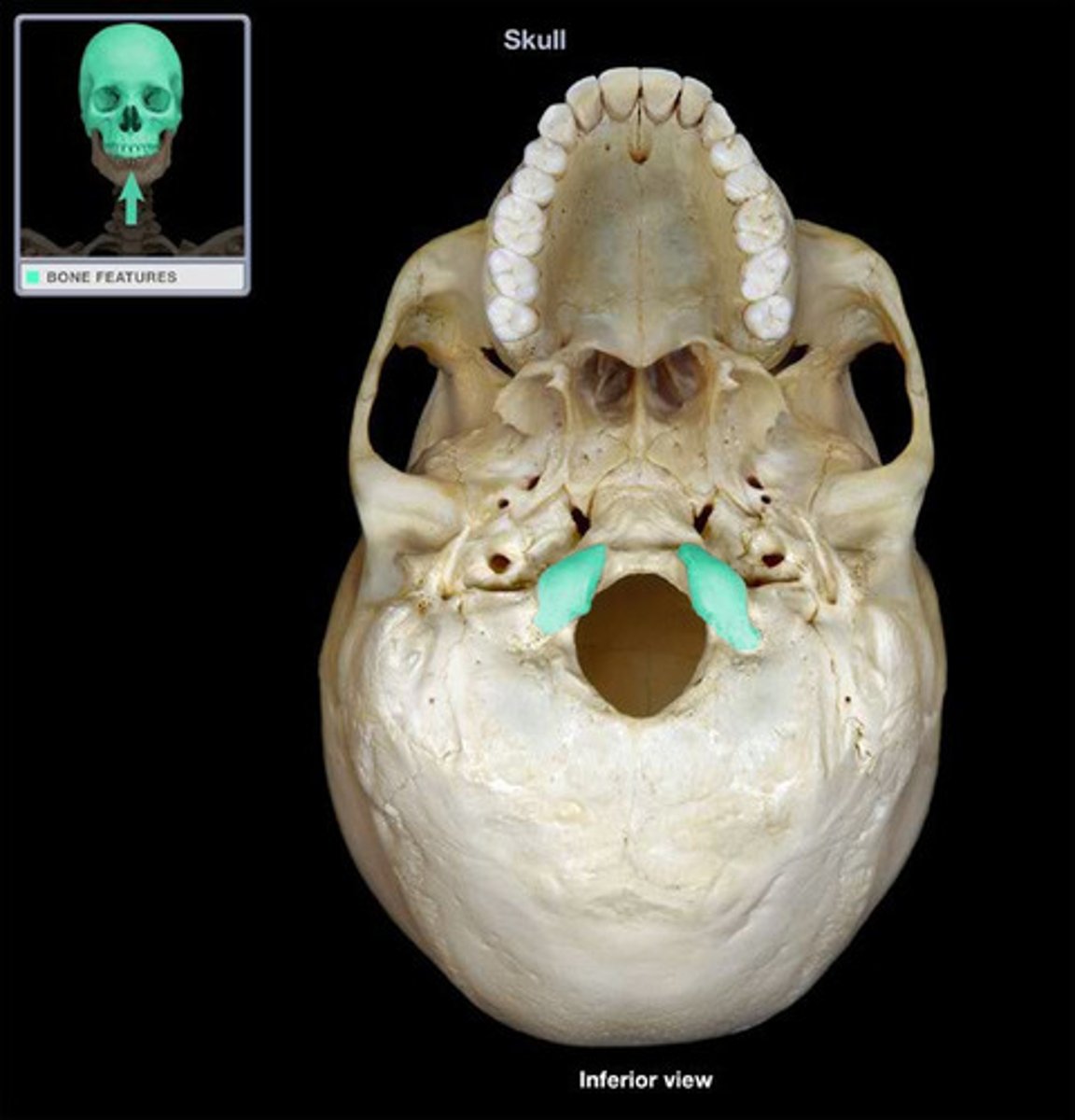
External Occipital Protuberance
attachment for neck and back muscles positioned most posteriorly

Atlanto-Occipital Joints
Joints on the Atlas segment where superior articular facets allow the occipital condyles to rest; the "Yes" joint; Jefferson Fracture
lateral atlantoaxial joint (Right and Left)
Inferior articular facets of the Atlas; Part of the "No" joints
median atlantoaxial joint
the Anterior articular facet on the Dens helps to form this joint; part of the "No" joints
Tectorial Membrane
Continuation of PLL connecting the Atlas to the Occipital bone aong the anterior side of foramen magnum
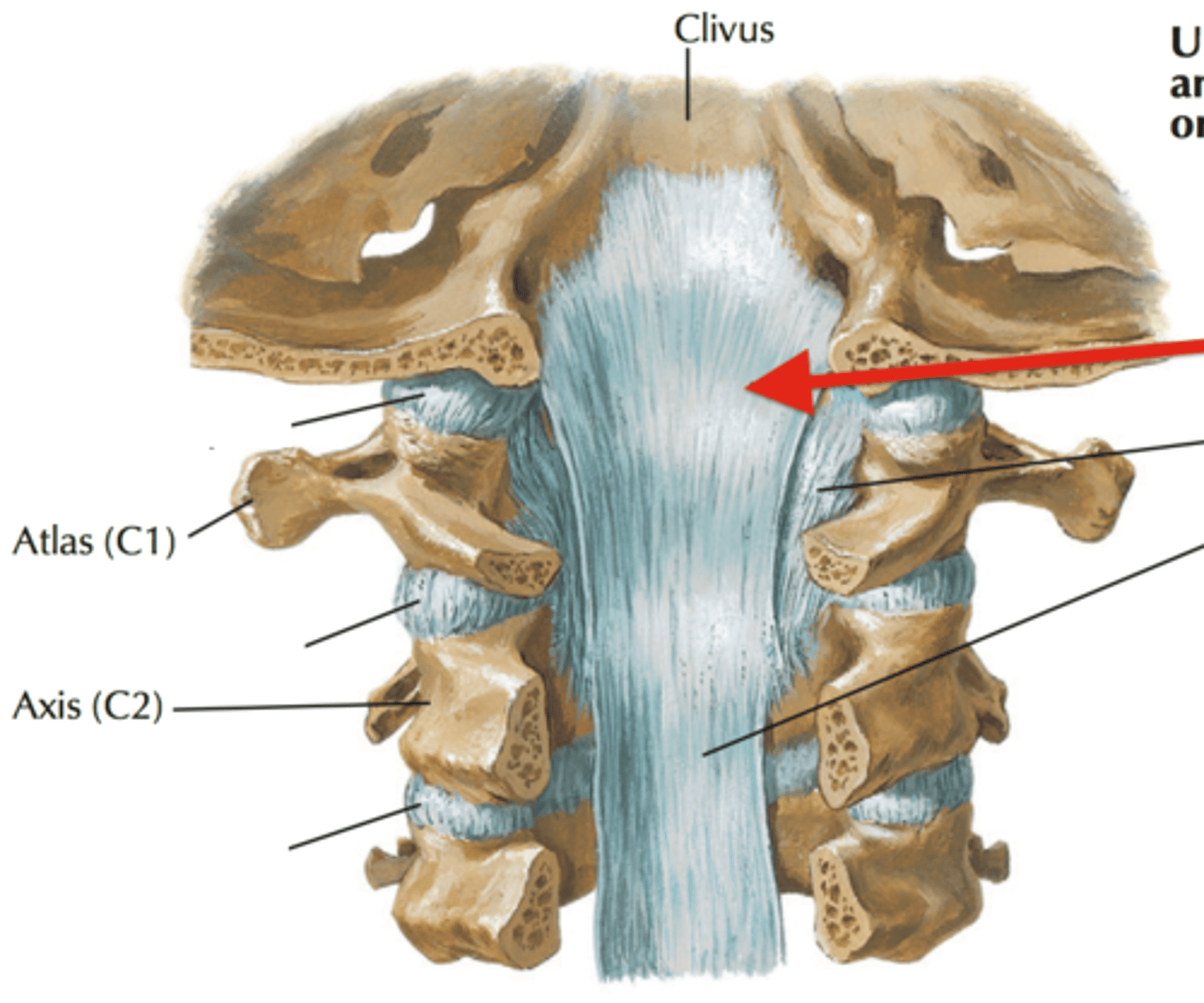
Cruciform Ligament
Transverse and Longitudinal portions; lies deep to the Tectorial membrane
Transverse Ligament of the Atlas
Forms a collar around the Dens; maintaining median atlantodental joint; Rupture may lead to injury of spinal cord by wandering Dens
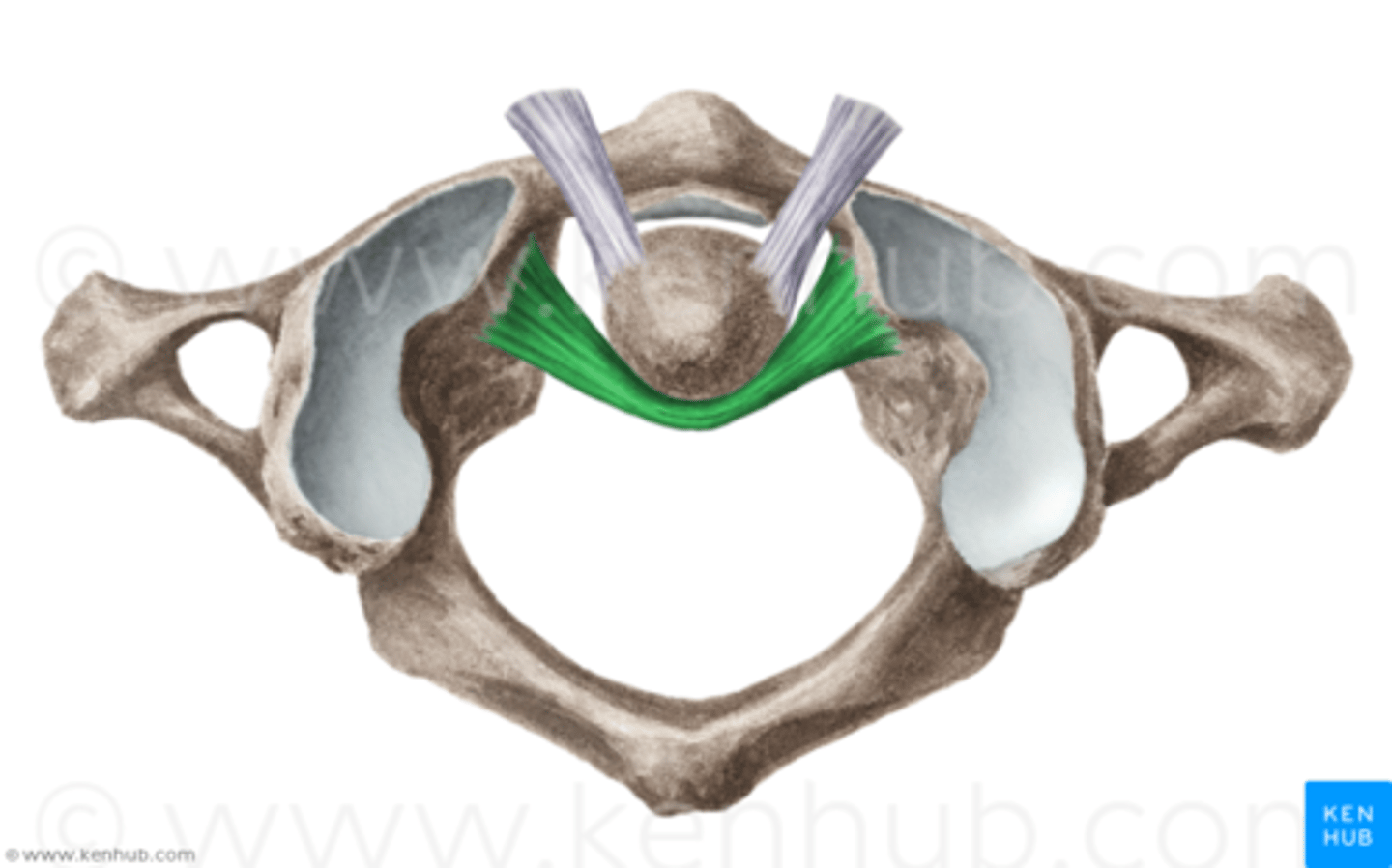
Alar Ligaments
Extend from Dens to occipital condyles; each limit rotation and lateral bending of the head; Hyperflexion injury
Ligamentum Nuchae
Runs from External Occipital Protuberance down to C7; provides surface for attachment of posterior cervical muscles that maintain head position
Actions of Posterior Neck Muscles (Nuchal Musculature)
Resist flexion of the head; and reposition sense organs in the skull
C1 Dorsal Ramus Innervations
Sub occipital muscles (obliquus capitis superior, Obliquus capitis inferior, Rectus capitis posterior major, and Rectus capitis posterior minor
contents of suboccipital triangle
Vertebral Artery, Sub-Occipital Nerve, Posterior arch of atlas
The greater Occipital Nerve
Supplies the skin overlaying the triangle and posterior scalp
Atlanto-Occipital membrane
Where vertebral arteries pass through to enter the foramen magnum (membrane); ossification of this can lead to LOC in elderly patients with their head back
Mediastinum
Mid-line soft tissue that separates pulmonary cavities
Superior Thoracic Aperture
Transmits abundant viscera and neurovascular between thorax and neck
Manubrium
Literally meaning "Handle"; top portion of the sternum; articulates with the clavicles and costal cartilages of the first ribs
Body (Gladius)
Articulates with costal cartilages of ribs 3-7; middle portion of sternum
Xiphoid Process
Embedded in anterior wall musculature; inferior tip of sternum
Sternal Angle
Ridge between manubrium and body at second rib (Palpable); in line with spine at T4-T5 vertebrae
True Ribs
Ribs 1-7; articulate with sternum via their own costal cartilages
False Ribs
Ribs 8-10; have cartilages that articulate with the next highest one
Floating Ribs
Ribs 11-12; No sternal articulation
Head of Ribs
Part of the rib that connects to the vertebrae at costal facets
Costal Groove
Contains and Protects intercostal neurovasculature bundle
Rib 1
Surface features of this rib includes scalene tubercle and grooves for subclavian vessels
Scalene Muscles
run between cervical spine and upper ribs; serve as accessory muscles for breathing
Primary Cartilaginous joint (Joint 1)
immobile, thin layer of hyaline cartilage; closer to the midline of the body
Costochondral Joints (Joints 2-7 on the rib cage)
Allows gliding of the ribs to assist in breathing; plane synovial joints
External interocostals
Run Anteroinferiorly from the rib above to the rib below; most active during inspiration to ELEVATE the ribs
internal intercostals
Run Inferoposteriorly from floor of costal grooves to ribs below; most active during expiration to DEPRESS the ribs
innermost intercostals
Same action as internal intercostals; helps to house the neurovasculature bundle between it and the muscle layer above it

Transversus Thoracis
Limited to the anterior chest wall; Origin: ribs 2-6 inner layer of intercostal cartilage; Insertion: surface of sternum and xiphoid process; Action: Lowers ribs; Innervation: 2-7th intercostal nerves
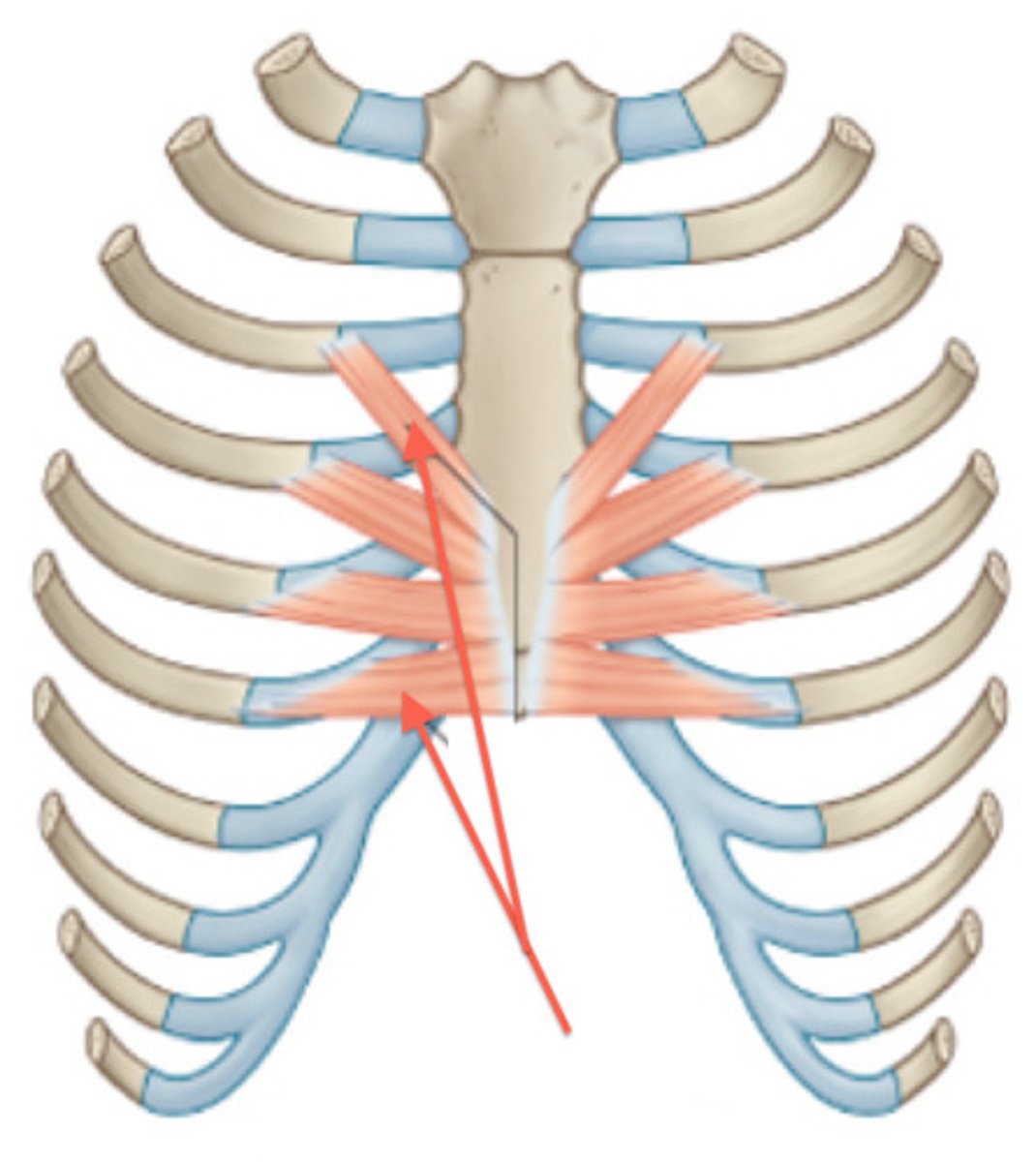
Direction of neurovasculature bundle Superior to Inferior
Veins, Arteries, nerves